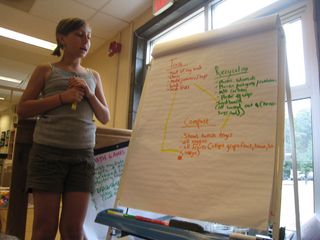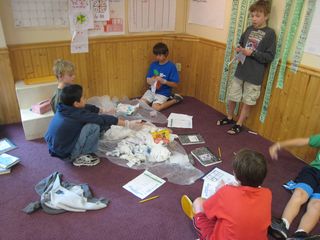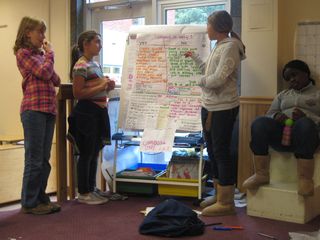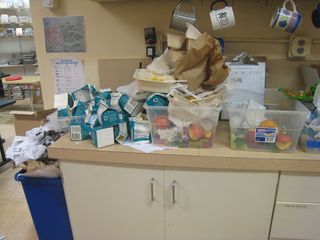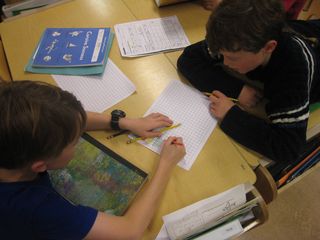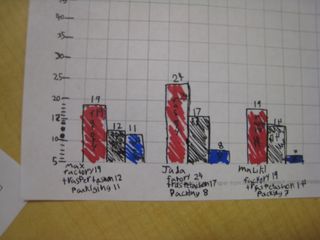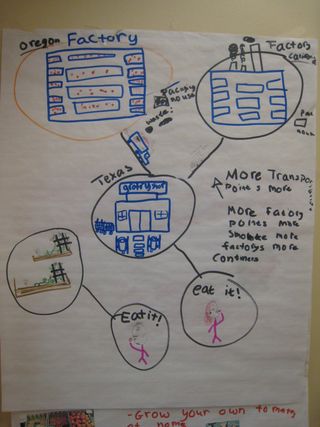Wondering about Waste
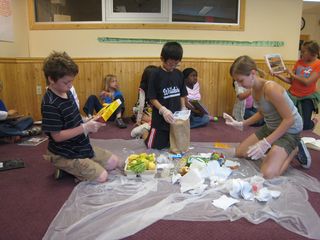
What will we do with the trash?
Our intention as a staff this year was to focus on the idea of food to table – exploring how the food we eat gets to us and what impact it has along the way. I wanted to start with waste in Opal 3, because I was eager to see if we could impact the waste we already produce as a classroom.
First day provocation in early October: I took away the garbage bins, and told the story of the garbage barge that couldn’t find a place to dump its load. I told the students that I was worried about running out of landfill space and I didn’t want to contribute to landfills anymore. Later that day, I gathered the class on the stage and asked them to figure out what to do with all the trash.
The students quickly realized that they could sort what had been thrown away. They found what they thought was recyclable or compostable, based on what they already knew from recycling and/or composting at home.
That same day, the students came up with an initial plan to recycle and compost in the classroom.
Over the next few days, the students consulted non-fiction materials to see whether our initial sort of the waste was accurate. They found out that much of what they assumed was recyclable was not.
They also learned what can and cannot be composted in a home-compost (the black) bin like the one we have at school.
How can we keep the trash we produce in our classroom
out of the landfill?
This question lingered in our classroom, especially in light of our discovery of the “green bin” – business composting available through the city of Portland.
For about a month, the class sorted how much would go into the black, green, blue and landfill bins and recording the volumetric data. We noticed that the students in Opal 3 don’t always remember where each type of trash should go. Harry volunteered to be the class “Trash Sorter” and stand by the bins to remind people where to put their trash. We also noticed that the waste we produce in our classroom is mostly food related waste.
So we wondered, where does all of this food related waste come from? For homework one weekend, the students tracked what they ate and what packaging it came in. Then they combined and graphed their data in their table groups.
The students also estimated what we call their transportation and factory points. Factory points tell you how much time the food you ate spent in a factory, 0 – 3, based on how processed it is. A whole food gets 0 points and one that comes ready to eat in a whole new form out of a package gets 3 points.
Transportation points tell you how far your food had to travel to get to your table, 0 points if it comes from your backyard and 3 points if it comes from outside the region where we live.
What do factory points and transportation points have to do with waste?
We had a science talk about this question.
Michael came up with a metaphor connecting the waste bin in our classroom to the factory and transportation points:
one single candy bar goes through so much waste you don’t even know about."
Abigail and Riley wondered if you walked to the grocery store and bought a tomato from Egypt for $1 a pound compared to driving 30 minutes to Sauvie Island or to New Seasons to buy local, organic tomatoes, which one really produces the most waste? The impact of that one tomato on a truck or train or the impact of you driving across town to make the local choice?
Alex invented her own version of carbon offsets, and Abigail and Riley are making sense of it all based on their own experiences and schema.
The big question remains: Where will we go from here?
There are so many possibilities. Here are some big questions I am pondering…


